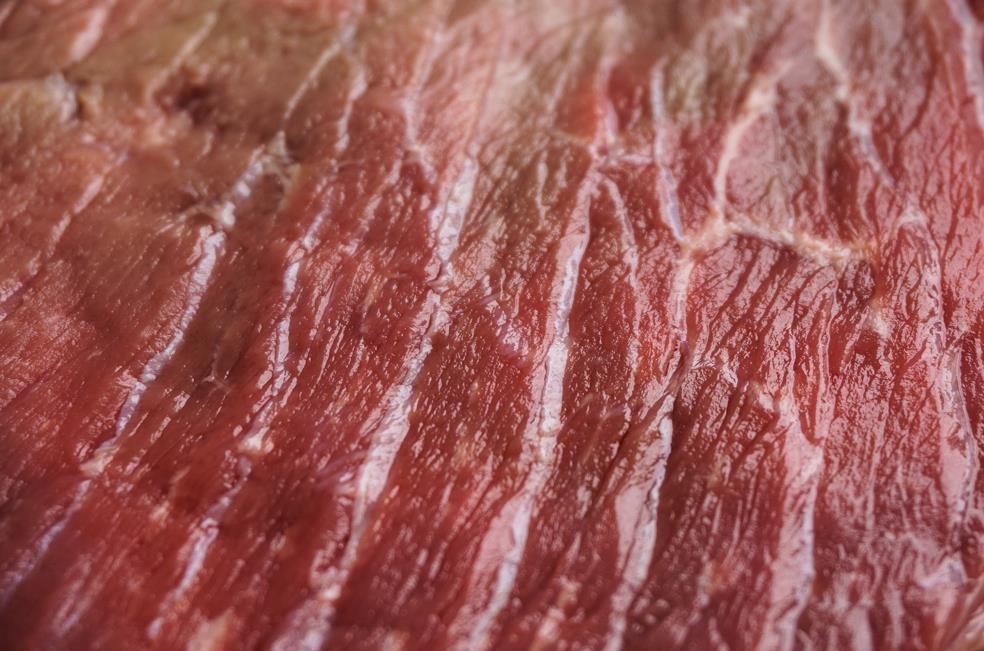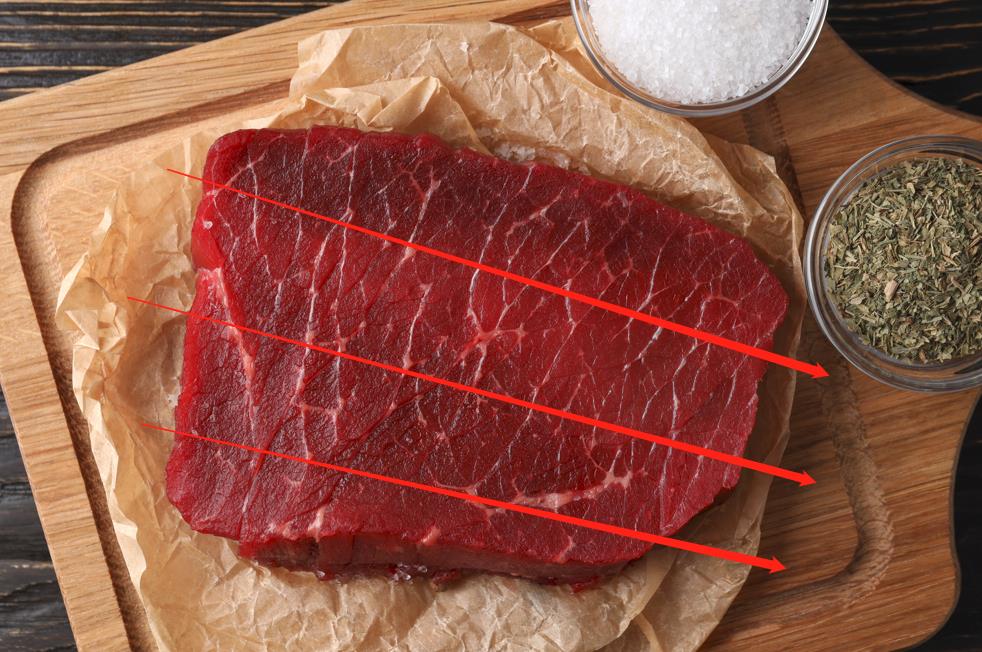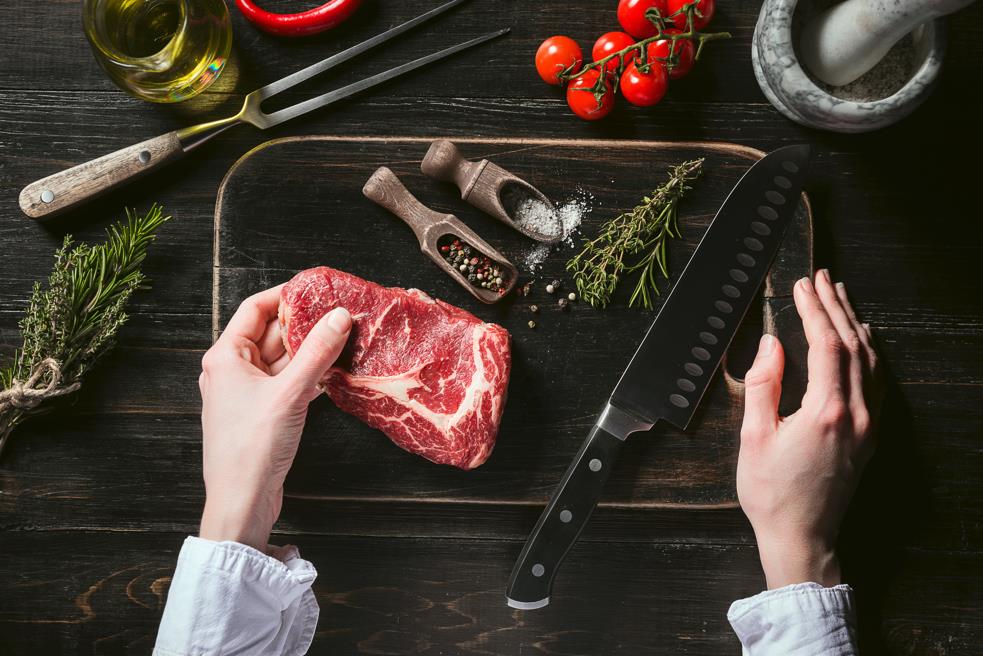Cooking meat is no easy task. Each step plays a vital role, from seasoning to slicing the final product. Pick up the best seasoning, throw the meat on the heated pan, baste, and rest adequately. Later comes slicing, yet a crucial step is often underlooked – and that is doing it the right way.
Even if you nail everything and cook the best meat that there is, the way you slice it will determine a huge part of its chewiness and tenderness. The goal is always to create slices with short muscle fibers so that literally every bite melts in your mouth.
Sounds straightforward enough but often not talked as much compared to the steps that come before slicing. In this article, we’ll talk about how to cut meat against the grain, why it matters, and give tips.
Table of contents
What is meat grain?

The meat we eat is mostly the muscle tissue, and like any other, it’s made up of fibers that come together to form a chunk of meat. These bundled muscle fibers run in a certain direction, creating what we call the grain.
However, the grain isn’t always the same across a piece of meat. That’s why it’s crucial to examine the meat and figure out which way the grain goes.
How to tell the grain of the meat?
It’s pretty easy to identify the grain in some cuts of meat like a sizable flank steak. It mostly runs in the same direction, and you should always cut against it.
In other cuts of meat like shank, the front legs, the grain runs in many different directions with lots of connective tissue. This variety of grain in a single piece of meat is one of the reasons why these parts are more for stews rather than steak.
Regardless of the cut of meat, though, identifying the grain is not complicated. Look for bundles of muscle fibers that run in the same direction. Do a little bit of trimming if they’re not perceptible right away.
Why is cutting against the grain important?
Cutting the meat perpendicular to the grain will give you shorter fibers that are easier to chew in each piece. The muscle fibers are strong by nature, and our teeth aren’t the best tool to cut them. That’s why meat can be chewy if not cooked or sliced correctly.
After cooking the meat, the fibers become easier to chew but are still strong enough to need some chewing. Although not cutting against the grain won’t give you as chewy bites as an overcooked steak, perfecting every bite lies in forming slices of meat with short fibers.
Here is a little demonstration to better understand why meat pieces cut against the grain are easier to chew.
Cut against vs. with the grain
Cut a small piece of meat with the grain and pull from one end of the muscle fibers to the other. It will be virtually impossible to tear them apart as the fibers are running in the same direction and are stacked on top of each other.
Now, cut another piece of meat, but against the grain this time. Pull apart the meat while the grain runs vertically to your hands. It will be significantly easier to break the meat because you’ll be pulling the bundles of fibers away from each other instead of stretching them to break.
It isn’t so different in the mouth when you chew. Long muscle fibers mean you’ll need to do more chewing to break them to become easier to swallow. On the other hand, short fibers will break easily. You won’t need to cut them in your mouth as you chew, resulting in not only easier to chew bites but flavorful and tender.
How to cut meat against the grain?

To cut meat against the grain, you first need to figure out the direction of the grain. This is the same for all types of animal protein, whether it be fish, poultry, pork, beef, or any other. It might be difficult to find the grain in white meat first, especially in chicken breasts, but knowing where to look makes all the difference.
Step by step
- In a well-lit part of your kitchen, look closely at the surface of the meat.
- Identify the grain by finding the bundles that run parallel in the same direction.
- Cut perpendicular to the grain to have slices with shorter fibers.
If the grain is mostly similar, you can slice the entire meat against the grain at once. If the grain runs in multiple different directions, it’s best to separate them first and create blocks of meat to cut afterward.
Additionally, for certain dishes that require cubed meat like stews, start by slicing narrowly against the grain first to create strips. From there, you can cut the strips into cubes. This technique will give you shorter fibers across the cubes compared to randomly cutting the meat into strips then into cubes.
Best knife to cut meat
True cutting power in the palm of your hand
Raw vs. cooked meat
There aren’t differences between slicing raw and cooked meat in terms of cutting it against or with the grain. In most cuts of beef, it’s easier to identify the grain when it’s raw. For example, flank steaks have long muscle fibers that are reasonably visible. Still, it isn’t as easy to spot them after being cooked.
However, just because it’s easier to find the grain before cooking the meat doesn’t mean you should cut it before cooking. Cut meat before cooking if you like it more evenly cooked. Note that cutting meat into small chunks before cooking will give you pieces cooked mainly the same inside and outside.
For tacos, salads, pasta, or other foods that require small pieces, you’re mostly better off slicing after cooking the meat. Cooking a larger piece of meat will keep most of the moisture in compared to a smaller one, which can result in drying it out. After it’s rested enough, you can slice against the grain to have tender bites to add to complement dishes.
Other tips on cutting meat

Cutting against the grain is undoubtedly vital, but there are other things you can do to make everything even better. Here are additional tips for getting juicy, tender bites of meat every time.
The thickness of your slice
How thick you slice the meat also matters significantly, especially when cutting it before cooking. If the meat is too thin, it’s more prone to overcook and undercook if too thick.
When portioning meat for steak, the ideal thickness is about 1.5 inches. This is thin enough to allow the heat to infiltrate the surface and travel to the center yet thick enough to prevent undercooking.
Choose the right knife
There are plenty of different knives you can use to cut meat. Although you can use the same knife throughout preparing meat, specialty knives can make it easier. A boning knife to separate meat from the bones, a slicing knife to portion, and a chef’s knife for general purposes.
Arguably, a large enough utility knife will suffice for most cooks, but Japanese alternatives like the Sujihiki might be a better fit if you’re cutting meat regularly.
There are also serrated steak knives. These knives don’t require a downward push to cut like bread knives. As a result, it won’t create pressure on the surface while you slice and will not squeeze out the juices inside.
Enough rest
All animal protein needs rest after cooking. The juices inside need enough time to redistribute. The heat moves the liquids upwards to the center and forms a build-up fluid. Since you don’t want all the tasty juice to drip away to your cutting board, it’s best to give it at least five to ten minutes of rest.
Takeaway
Cutting meat against the grain is crucial. When not done correctly, the outcome won’t be as great even if everything else is in order. It’s one of those small things that make a significant difference.
With the right knife, the whole experience becomes even better. Shop for handmade carbon steel kitchen knives on our collection and learn more about cutting other ingredients on the HDMD Knives Blog.












